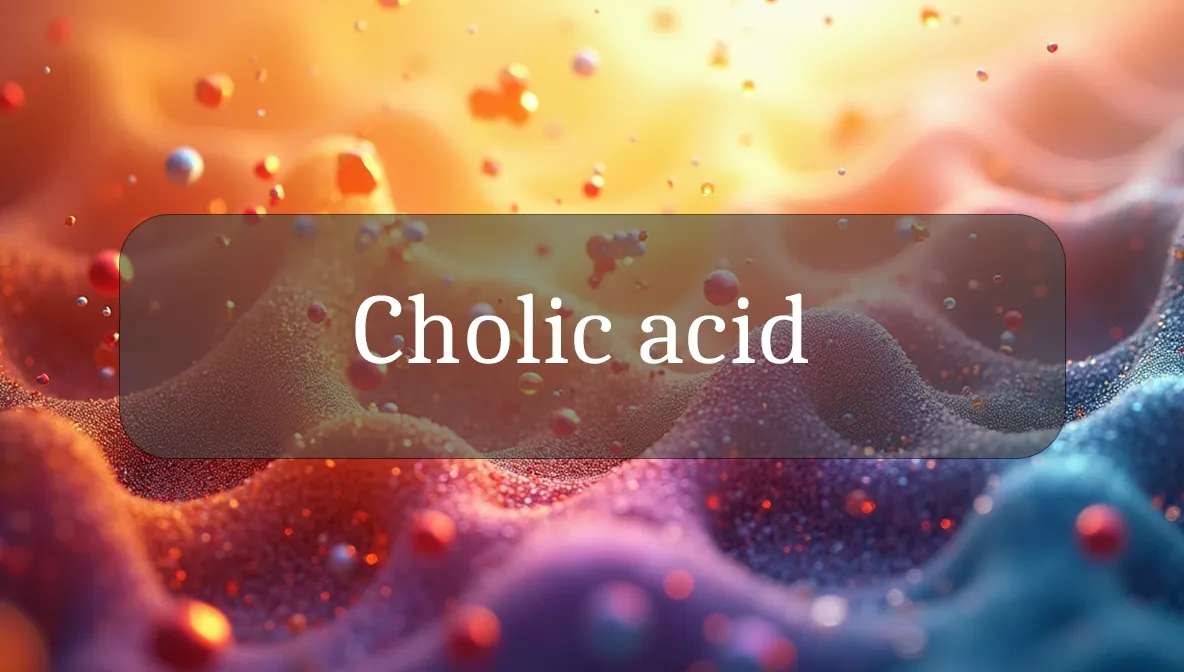Bile Acid for Fat Digestion and Cholesterol Balance
Cholic acid is a primary bile acid made in the liver, essential for digesting fats and regulating cholesterol. This guide explains what cholic acid is, its role in your body, and practical ways to support its function through diet and lifestyle, all in a clear and actionable way for daily wellness.
Chemical Identity and Type
Cholic acid is a steroidal bile acid, derived from cholesterol in the liver, with the chemical formula C₂₄H₄₀O₅. It’s one of the two main primary bile acids (alongside chenodeoxycholic acid) in humans. Conjugated with glycine or taurine, it’s stored in the gallbladder and released into the small intestine to aid digestion. Think of cholic acid as a natural emulsifier that helps your body process dietary fats efficiently.
Biological Role and Benefits
Cholic acid plays several vital roles:
- Fat Digestion: Breaks down dietary fats and cholesterol into micelles, enabling absorption of fat-soluble vitamins (A, D, E, K) in the small intestine.
- Cholesterol Regulation: Facilitates cholesterol excretion through bile, lowering blood cholesterol levels and reducing gallstone risk.
- Liver Protection: Regulates bile acid synthesis via the farnesoid X receptor (FXR), preventing toxic bile buildup in the liver.
- Gut Microbiome Health: Shapes gut bacteria composition, promoting beneficial microbes and reducing inflammation.
- Metabolic Health: Influences glucose and lipid metabolism, potentially aiding insulin sensitivity.
In balanced amounts, cholic acid supports digestion, liver function, and metabolic wellness.
Dietary or Natural Sources
Your liver produces cholic acid from cholesterol, but diet and lifestyle impact its synthesis:
- Indirect Dietary Support:
- Fiber-rich foods: Oats, lentils, apples, and carrots (soluble fiber binds bile acids, promoting cholic acid excretion and cholesterol reduction).
- Healthy fats: Olive oil, avocados, and fatty fish (e.g., mackerel) stimulate bile release, including cholic acid.
- Low-cholesterol foods: Whole grains (e.g., barley), fruits, and vegetables reduce excess cholesterol, supporting balanced cholic acid production.
- Foods to Avoid:
- High-saturated-fat foods: Fatty meats, butter, and fried foods increase cholesterol, potentially straining bile acid pathways.
- Refined sugars: Sugary drinks and desserts disrupt bile acid metabolism, raising gallstone risk.
- Supplemental Sources (medical use only):
- Cholic acid medications: Prescribed (e.g., Cholbam) for rare bile acid synthesis disorders or peroxisomal disorders (50–100mg/kg daily, under supervision).
- Ursodeoxycholic acid (UDCA): A related bile acid, sometimes used for similar purposes.
- Lifestyle Factors:
- Regular meals, exercise, and weight management optimize bile flow and cholic acid function.
Focus on fiber and healthy fats to enhance natural cholic acid production and bile health.
Signs of Imbalance or Dysfunction
Imbalances in cholic acid can lead to digestive or liver issues:
- Deficiency or Impaired Synthesis:
- Symptoms: Fat malabsorption (bloating, greasy stools, vitamin deficiencies), gallstones, or liver dysfunction.
- Causes: Liver disease (e.g., hepatitis), bile duct obstruction, or rare genetic disorders (e.g., Zellweger syndrome).
- Risks: Elevated cholesterol, gallstone formation, or liver damage.
- Excess Cholic Acid (rare, typically from supplementation):
- Symptoms: Diarrhea, abdominal pain, or liver enzyme elevation from high-dose cholic acid medications.
- Risks: Potential liver stress or digestive irritation with prolonged overuse.
- Related Conditions:
- Gallstones: Low cholic acid relative to cholesterol in bile promotes stone formation.
- Cholestasis: Impaired bile flow reduces cholic acid delivery, causing jaundice or liver damage.
- Dysbiosis: Gut microbiome imbalances can alter cholic acid metabolism, increasing inflammation.
If you experience digestive issues, greasy stools, or yellowing skin, consult a healthcare provider. Blood tests (liver function, bile acids) or imaging (ultrasound) can diagnose cholic acid-related problems.
Supporting Optimal Levels or Function
To optimize cholic acid function and bile health:
- Adopt a Bile-Supportive Diet: Eat 25–35g fiber daily (e.g., oats, beans, broccoli) to bind bile acids and lower cholesterol. Include healthy fats (e.g., olive oil, salmon) to trigger bile release. Limit saturated fats (<10% of calories) and refined sugars.
- Eat Regular Meals: Space meals 3–5 hours apart to promote steady bile flow, preventing cholic acid buildup in the gallbladder.
- Exercise Regularly: Aim for 150 minutes of moderate activity (e.g., walking, swimming) weekly to enhance lipid metabolism and bile production.
- Maintain a Healthy Weight: Losing 5–10% of body weight if overweight reduces gallstone risk and supports cholic acid function.
- Limit Alcohol: Excessive alcohol disrupts bile acid metabolism; stick to moderate amounts (1 drink daily for women, 2 for men) or avoid if non-drinker.
- Avoid Rapid Weight Loss: Crash diets increase cholesterol in bile, reducing cholic acid’s effectiveness and raising gallstone risk.
- Medical Supervision for Supplements: Use cholic acid medications only under a doctor’s guidance for specific disorders, with regular liver function monitoring.
These habits ensure cholic acid supports digestion and liver health effectively.
Safety, Interactions, and Precautions
Cholic acid is safe when naturally produced, but medical use requires caution:
- Safety: Endogenous cholic acid is tightly regulated. Cholic acid medications can cause diarrhea, liver toxicity, or digestive issues if misused.
- Interactions:
- Cholic acid medications may interact with bile acid sequestrants (e.g., cholestyramine) or cholesterol-lowering drugs (e.g., statins), requiring dose adjustments.
- High-fat diets or alcohol can overload bile acid pathways, reducing cholic acid’s efficiency.
- Precautions:
- If you have liver disease, gallstones, or cholestasis, consult a doctor to assess bile acid status and treatment needs.
- Avoid cholic acid medications if pregnant or breastfeeding unless prescribed, due to limited safety data.
- Regular monitoring (e.g., liver function tests) is essential during cholic acid therapy.
Fun Fact
Cholic acid is your gut’s fat-fighting partner! It turns creamy sauces or oily fish into tiny droplets your body can absorb, making every bite of your favorite meal work for you.
Citations
- National Institutes of Health. (2024). Bile Acids and Metabolic Health.
- Mayo Clinic. (2023). Gallstones and Bile Acid Disorders.
- Cleveland Clinic. (2024). Bile Acid Function and Digestion.
- World Health Organization. (2022). Nutrition: Fats and Liver Health.
- ScienceDirect. (2024). Cholic Acid: Role in Health and Disease.

